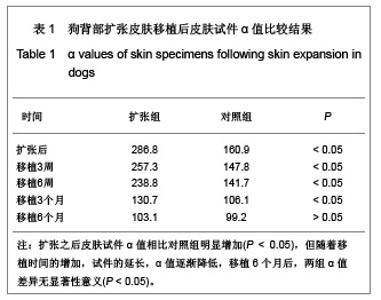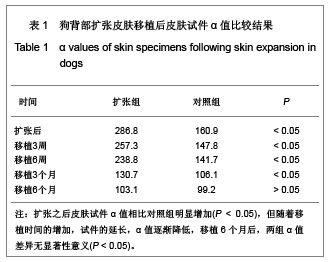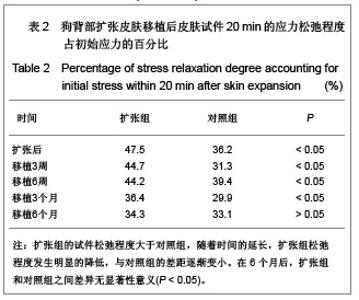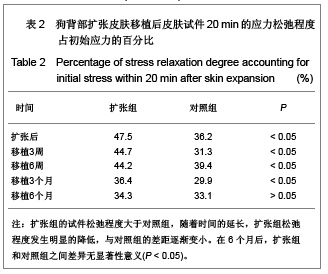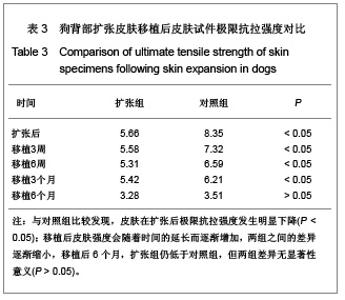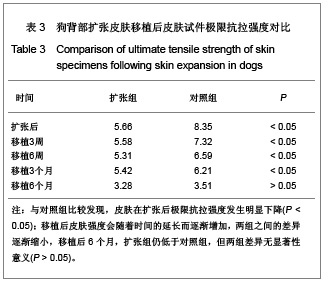| [1] Yang Q, Li XL, Zhang Y.Guoji Shengwu Yixue Gongcheng Zazhi. 2012,35(5):308-311. 杨青,李秀兰,张扬,等.毛囊干细胞的研究进展[J].国际生物医学工程杂志,2012,35(5):308-311.[2] Hu H, Sun G, Zhang Z, et al. Long-term changes after transplantation of expanded skin in dogs. Zhonghua Zheng Xing Wai Ke Za Zhi. 2002;18(3):175-176.[3] Bayat M, Chelcheraghi F, Piryaei A, et al. The effect of 30-day pretreatment with pentoxifylline on the survival of a random skin flap in the rat: an ultrastructural and biomechanical evaluation. Med Sci Monit. 2006;12(6):BR201-207.[4] Zhao JY, Chai JK, Song HF, et al. Effects of hyaluronic acid on biomechanic performance of porcine acellular dermal matrix plus thin skin autograft after transplantation. Zhonghua Yi Xue Za Zhi. 2012;92(24):1719-1722.[5] Han YD, Liu L. Guoji Pifu Xingbingxue Zazhi. 2007,11(23): 340-342. 韩跃东,刘玲.组织工程皮肤的临床应用[J].国际皮肤性病学杂志, 2007,11(23):340-342.[6] Zhang ZW, Sun GC, Yu HY. Zhongguo Meirong Yixue. 2010; 9(23):247-250. 张正文,孙广慈,侴海燕.扩张皮肤生物学转归的临床观察[J].中国美容医学,2010,9(23):247-250.[7] Zhang ZW, Lu W. Linchuang Yixue. 2010,20(23):1-2. 张正文,卢伟.扩张皮肤移植后的组织学转归[J].临床医学,2010 , 20(23):1-2.[8] Zhang ZW, Zhai HF, Kang SS, et al. Zhongguo Meirong Yixue. 2006,23(03):183-185. 张正文,翟弘峰,康深松,等.扩张皮肤移植后的生物力学变化[J].中国美容医学,2006,23(03):183-185.[9] Zhang EP, Li XY, Wang SJ, et al. Hangtian Yixue yu Yixue Gongcheng. 2005;18(4):276-280. 张恩平,李晓阳,王淑杰,等. 扩张皮片游离移植后远期生物力学特性的研究[J]. 航天医学与医学工程,2005,18(4):276-280.[10] Zeng YJ, Xu CQ, Yang J, et al. Biomechanical comparison between conventional and rapid expansion of skin. Br J Plast Surg. 2003;56(7):660-666.[11] Zhang J, Zeng YJ, Huang K, et al. Zhongguo Shengwu Yixue Gongcheng Xuebao. 2009;21(02):196-197. 章晶,曾衍钧,黄昆,等.扩张皮肤移植后的生物力学特性[J].中国生物医学工程学报,2009,21(02):196-197.[12] Bartell TH, Mustoe TA. Animal models of human tissue expansion. Plast Reconstr Surg. 1989;83(4):681-686.[13] Zhao R, Zhang GA. Zhonghua Shaoshang Zazhi. 2012; 28(4): 306-306. 赵冉,张国安. 内窥镜辅助下组织扩张器置入术在面颈部烧伤瘢痕重建中的应用[J]. 中华烧伤杂志,2012,28(4):306-306.[14] Ibrahim AE, Debbas CC, Dibo SA, et al. Reverse tissue expansion by liposuction deflation adopted for harvest of large sheet of full-thickness skin graft. Ann Burns Fire Disasters. 2012;25(2):98-101.[15] Biedermann T, Böttcher-Haberzeth S, Klar AS, et al. build, restore, reinnervate: do human tissue engineered dermo-epidermal skin analogs attract host nerve fibers for innervation? Pediatr Surg Int. 2013;29(1):71-78.[16] Zhu F, Liu Y, Li XJ, et al. Zhongguo Meirong Yixue. 2011; 22(08):1091-1093. 朱飞,刘烨,李小静,等.封闭负压引流技术结合邻近皮瓣转移修复难治性组织缺损[J].中国美容医学,2011,22(08):1091-1093. |
